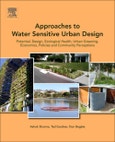Approaches to Water Sensitive Urban Design: Potential, Design, Ecological Health, Economics, Policies and Community Perceptions covers all aspects on the implementation of sustainable storm water systems for urban and suburban areas whether they are labeled as WSUD, Low Impact Development (LID), Green Infrastructure (GI), Sustainable Urban Drainage Systems (SUDS) or the Sponge City Concept. These systems and approaches are becoming an integral part of developing water sensitive cities as they are considered very capable solutions in addressing issues relating to urbanization, climate change and heat island impacts in dealing with storm water issues.
The book is based on research conducted in Australia and around the world, bringing in perspectives in an ecosystems approach, a water quality approach, and a sewer based approach to stormwater, all of which are uniquely covered in this single resource.
Please Note: This is an On Demand product, delivery may take up to 11 working days after payment has been received.
Table of Contents
1. History of WSUD / LID adoption in Australia and internationally John Radcliffe 2. WSUD approaches and their description Alan Hoban 3. Stormwater quality, pollutant sources, processes and treatment options Ashantha Goonetilleke and Jane-Louise Lampard 4. WSUD design guidelines and data needs Ashok K Sharma, Samira Rashetia, Ted Gardner and Don Begbie 5. The Role of Policy and Regulations in WSUD Implementation Grace Tjandraatmadja 6. Flood and peak flow management using WSUD systems Baden Myers and David Pezzaniti 7. WSUD approaches in Sewer System overflow management Leila Talebi and Robert Pitt 8. Erosion and Sediment ControlWSUD during the construction phase of land development Leon Rowlands 9. Water harvesting potential of WSUD approaches David Hamlyn-Harris, Tony McAlister and Peter Dillon 10. Using WSUD to restore pre-development hydrology Anthony Richard Ladson 11. Urbanization: hydrology, water quality and influences on ecosystem health Fran Sheldon, Catherine Leigh, Wendy Neilan, Michael Newham, Carolyn Polson and Wade Hadwen 12. Protecting and Managing Stream Morphology in Urban Catchments using WSUD Geoff J. Vietz and Robert J. Hawley 13. Urban Lakes as a WSUD Method Christopher Walker and Terry Lucke 14. Economics of WSUD approaches Kym Whiteoak 15. Optimization of WSUD Systems: Selection, Sizing and Layout Graeme C. Dandy, Michael Di Matteo and Holger R. Maier 16. Infrastructure and urban planning context for achieving the visions of integrated urban water management and water sensitive urban design: the case of Melbourne Casey Furlong, Meredith Dobbie, Peter Morison, Jago Dodson and Micah Pendergast 17. Integration of WSUD and Mainstream special planning approaches: lessons from South Africa Elizelle Juanee' Cilliers and Hildegard Rohr 18. Role of WSUD in building sustainable liveable suburbs Beau Bradley Beza, Josh Zeunert and Frank Hanson 19. WSUD and Urban Heat Island effect Mitigation Elmira Jamei and Nigel Tapper 20. The role of green roofs and living walls as WSUD approaches in a dry climate Simon Beecham Mostafa Razzaghmanesh, Rosmina Bustami and James Ward 21. Greening and cooling the city using novel urban water systems: a European perspective Martina Winker, Simon Gehrmann, Engelbert Schramm, Martin Zimmermann, Annette Rudolph-Cleff 22. WSUD asset management operation and maintenance Jack Mullaly 23. Capacity building for WSUD Implementation Rob Catchlove, Susan van de Meene and Sam Phillips 24. Community perception of the implementation and adoption of WSUD Approaches for Stormwater management Rosemary Leonard, Sayed Iftekhar, Melissa Green, and Andrea Walton 25. Post implementation assessment of WSUD approaches: Kanas City case Deborah O'Bannon and Yanan Ma 26. WSUD Implementation in a Precinct Residential Development: Perth case study Joshua Joseph Byrne, Melissa McGrath and Stewart Dallas 27. WSUD "Best in Class" - Case Studies from Australia, New Zealand, USA, Europe and Asia Stephen Cook, Marjorie van Roon, Lisa Ehrenfried, James LaGro Jr. and Qian Yu








